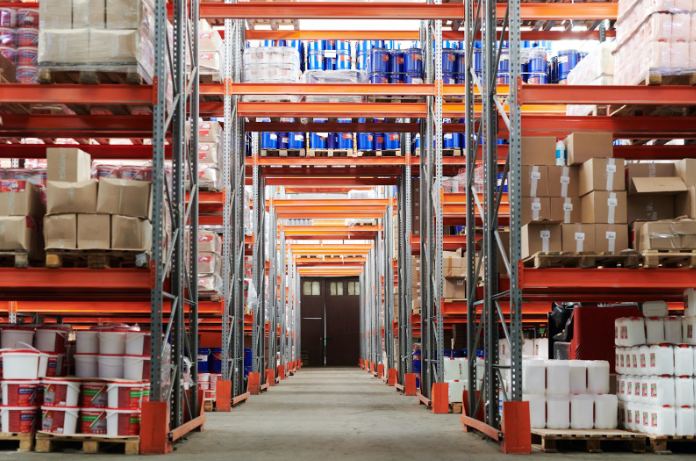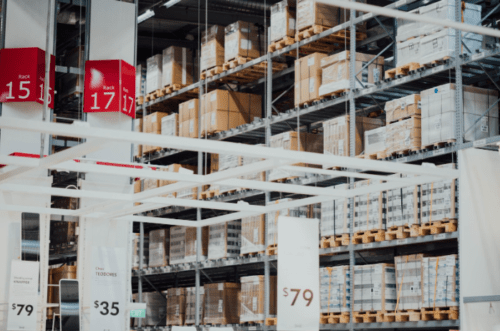Retail Warehousing: Definition, Types, and Benefits

Retail warehousing is an essential part of the supply chain, especially as businesses across the United States face a significant decline in storage capacities, according to the Wall Street Journal. E-commerce ventures are also on the rise, and these online retail shops need space to store, package, and brand their inventory to get it ready for distribution to customers.
These factors led to a newly branded breed of warehouses, the retail warehouse. With proper investment, management, and planning, these facilities can introduce many advantages to online retail and set retailers on a path to success.
What is a retail warehouse, and how does it function? Here’s a comprehensive guide to give you some insight.
What Is Retail Warehousing?
Initially, warehouses were separate entities that had little to do with a business or its operations. Times have changed, however, and today’s retail warehouses play a vital role in the supply chain and are at the core of every business.
Retail warehousing refers to the storage of a seller’s inventory and/or the place where online orders are fulfilled. Retail warehouses serve vital functions in the retail supply chain, from storage to packaging and delivering goods to consumers.
A perfectly organized and optimized retail warehouse means efficient and quality fulfillment of orders without having to deal with stockouts. On the other hand, disorganization in the retail warehousing process makes it challenging to keep track of inventory and efficiently implement fulfillment.
Types of Retail Warehousing
There are several types of retail warehouses available today. Here are the top choices for different businesses.
Cooperative Warehouse
A cooperative warehouse refers to the storage structures started and operated by cooperative entities. For instance, you may have heard of milk farmers’ cooperatives, winery cooperatives, fishing cooperatives, or others.
The cooperative warehouses are open to use by members and non-members. However, being a part of the operating cooperative means subsidized costs.
Also, most cooperative warehouses deal with specific products–farm produce, liquor, etc. Before choosing a cooperative warehouse, confirm that their services match your needs.
Private Warehouse
Private warehouses are owned and operated by private firms, including large retail stores, distributors, corporations, online marketplaces, and manufacturers. These facilities are also called proprietary warehouses. They require significant amounts of upfront capital to build and maintain.
Private warehouses are suitable for online small and mid-sized businesses – SMBs – requiring ample, long-term storage or any large corporation with similar needs. It’s worth noting that starting this type of warehouse costs more than the price of using a public warehouse.
Public Warehouse
Unlike private and cooperative warehouses that focus on specific groups of users, these mass storage facilities are third-party owned and operated, allowing any retailer to rent space. They’re available for use by any business, whether private-owned or not, or for personal use.
Public warehouses are comparatively cheap, making them suitable for SMBs looking for a reliable place to store retail goods for short or long periods.
One downside of these structures is that most of them aren’t as advanced in technology as private warehouses. However, they’re the most accessible and affordable option, especially if you’re starting an e-commerce or small business and want a cost-effective storage alternative.
The cost of renting a public warehouse varies, depending on how long you store your goods, the size of the commodities, and any additional services you require from the warehouse, such as shipping for example.
Smart Warehouse
Smart warehouses use advanced technologies, like AI, to complete tasks such as fulfillment processing, storage, and management. Smart warehouses use automation technologies, including management software, drones, and robots, to transport, pack, weigh, or store commodities.
Smart warehouses help limit human error, speeding consumer order fulfillment. An excellent example of a smart warehouse at work is the massive fulfillment performed at e-commerce retail stores like Alibaba and Amazon.

Benefits of Retail Warehousing
Retail warehousing comes with several benefits for business owners. Here are some reasons to consider this type of storage.
Increased Storage
Most retail businesses face the hurdle of finding sufficient storage for their products. Running an online business without sufficient storage can significantly hinder growth and make fulfilling large orders challenging,
Renting space at a retail warehouse offers a solution. Unlike traditional warehouse spaces, current storage structures have increased in size to make them suitable to store large amounts of inventory and every type of commodity.
Retail warehouses in the United States have expanded in size. The increased warehouse space means you can easily stock enough inventory to meet the demands of your customers.
Efficient Management
Management can be painless, depending on the type of retail warehouse you’re using. For instance, using a smart retail warehouse means the bots, drones, and AI applications can help you manage your inventory and fulfill orders efficiently.
Also, retail warehouses enable you to store many products under one roof. That way, you can easily track your inventory, stock up when necessary and expand your consumer base.
Easy management enables you to sufficiently meet your consumers’ needs and increase productivity and profits.
Centralization
One of the biggest advantages of using a retail warehouse is that it is a place to bring your goods together and prepare them for shipping. The warehouses enable you to pull goods to a central contact point for easy packaging, branding, and distribution.
The centralization streamlines inventory management and enables you to further develop strategies to enhance your business. This way, you know when to add more stock, what part of the order fulfillment process needs optimization, and which processes to revamp for more efficient business operations.
Enhanced Security
Retail warehouse operators implement measures to ensure high security for all the goods being stored. They also protect your inventory against fire and water hazards and theft.
Also, the facilities employ sufficient safety strategies to reduce the chances of spoilage and avoid breakages, accidents, and other forms of damage.
Keeping your goods at a warehouse makes them easy to manage and distribute. Also, it eliminates the fear of damage, theft, and other security concerns.
Key Components of Effective Retail Warehousing
Here are some key components of retail warehousing.
Inventory Management
One of the biggest challenges most SMBs and e-commerce ventures face is inventory management. Due to the challenges of storage space and issues with organization, it can be difficult to keep track of inventory, eliminate stock outs, and keep order fulfillment flowing.
While retail warehousing centralizes the warehousing function and eases management, you are still responsible for keeping your inventory available and organized. Having enough storage allows you to order sufficient inventory.
Not matching the quantity of your inventory with the demands of your consumers may lead to massive dead stock, which eats up storage space and increases fees. Some of the ways you can ensure proper inventory management include the following.
- Have enough safety stock to cater to emergencies.
- Keep updated on the latest customer demand, depending on trends and seasons. That will help you order the correct quantity of inventory and eliminate the risk of dealing with dead stock.
- Keep track of your inventory and order fulfillment processes so you know when it’s time to restock and avoid stockouts. That will help you eliminate backorders while keeping inventory holding costs at a minimum.
- Use automation warehousing solutions like inventory management software (IMS) to improve your processes.
- Ensure all the partners in your supply chain collaborate to offer a detailed image of all products in-store and in transit.

Logistics of Returned Goods
Returned goods are part of any retail business. Your customers will return goods for several reasons, and one of the essential components of retail warehousing is knowing how to manage these commodities.
But managing the logistics of returned goods is where important transactional data slips out of the view of most retailers without notice. These commodities are part of your inventory, and you must account for them to get the correct inventory audit reports.
Also, you must make viable decisions on how to handle these goods and keep your business profitable regardless of the quantity of returned commodities.
One way to successfully handle returned goods is to treat them as valuable products and store them properly until they go through a quality check. After that, you can decide whether to destroy the item or return it to the manufacturer as an inconsumable good.
The retail warehouse should also be capable of linking every returned good to the initial order for easy audit trail maintenance. A clear return policy also eases the process for you and your customers.
Alternatively, you can implement measures to reduce the chances of your customers returning their orders. Some of the ways to ensure this include:
- Confirm the expiration dates and that package seals are intact before shipping
- Ensure that you use the correct branding and packaging on customers’ orders
- Ensure proper product descriptions when shipping
- Ensure quick deliveries, proper management, and excellent customer service in general
Planning Out Order Volume
Achieving business growth also comes with the added responsibility of handling more orders than you initially did. One of the most significant components of a functional retail warehouse is to help you plan out order volumes sufficiently.
To cover the expanded supply chain, the retail warehouse requires enough staff, workflow, and storage space to ensure accurate, flawless, and timely order fulfillment. The more the warehouse helps you meet customer expectations, the higher the chances of growth for your business.
Failing to meet your customers’ needs as a result of late deliveries or unsatisfactory product shipments may discourage them from doing business with you next time.
Thus, ensure you have the proper alignment in your supply chain before entering any massive growth period. Ensure that the retail warehouse floor space is sufficient to accommodate the order volume, that you have sufficient staff to handle the additional operations, and that your processes are sufficiently optimized to meet the inflow of orders.
Frequently Asked Questions
Here are the frequently asked questions and answers to help you understand retail warehousing in detail.
Are there notable examples of retail warehousing?
Yes. Retail warehouses are located around the world to cater to the needs of e-commerce and other types of businesses.
Among the most notable retail warehouses serving clients across the globe include McDonald’s, Burger King, Shoprite, and others.
What are urban sheds?
Most warehouses are typically situated in cities. However, the cities and other urban centers harbor many consumers.
Urban sheds are small retail locations found in urban areas. The urban sheds (small warehouses in urban centers) are meant to bring the goods close to consumers and speed the delivery process.
What alternatives are there to retail warehousing?
Depending on your needs, you can also consider alternatives to retail warehousing. On-demand stores, for instance, are efficient for handling goods that don’t need long-term storage.
Also, you can consider multi-node fulfillment to place your goods in various locations and ease delivery to consumers nearby.
Distribution centers are suitable for products you’re supplying to your clients soon.
Are distribution centers similar to retail warehousing?
No. Both distribution centers and retail warehouses can help you hold your goods before dispersing them to your consumers. However, retail warehouses typically hold products until you find clients, which may take longer.
On the other hand, distribution centers are designed to help sellers store, pack, pick, and dispatch products to their customers. Their storages are relatively shorter term than retail warehouses.
Conclusion
The e-commerce and online retail industry is growing, and warehousing has always been a part of the process, directly and indirectly. However, the recent rebranding of these storage facilities as retail warehousing is making the industry more functional and is vital to business operations.
This article has offered a complete guide to retail warehousing and how it works to speed the supply chain and make businesses more efficient. With the examples above, you can decide what retail warehousing option works for you, considering your logistics processes and unique supply chain.
